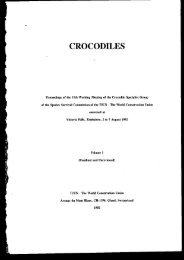CROCODILE SPECIALIST GROUP NEWSLETTER
CROCODILE SPECIALIST GROUP NEWSLETTER
CROCODILE SPECIALIST GROUP NEWSLETTER
Create successful ePaper yourself
Turn your PDF publications into a flip-book with our unique Google optimized e-Paper software.
the species is protected by law. RAPD was used to analyze<br />
70 DNA samples of Crocodylus acutus from the Jesus Maria,<br />
Tarcoles and Tusubres Rivers in the Central Pacific of Costa<br />
Rica in order to estimate genetic diversity, differentiation<br />
among populations, gene flow and genetic distance between<br />
them. Genetic diversity was low in the three rivers, H =<br />
0.2201 in the Jesus Maria river, 0.2358 in the Tarcoles river<br />
and 0.2589 in the Tusubres river. Among the three populations<br />
there is a metapopulational dynamic (GST = 0.0367), mainly<br />
between the populations of the Jesus Maria and Tarcoles<br />
Rivers. The value of gene flow (Nm = 13.1361) and the<br />
number of individuals reported for each river in 2004 suggests<br />
that the population of the Tarcoles River is the source and<br />
those from Jesus Maria and Tusubres are the drains. There<br />
was a direct relationship between the genetic distance and the<br />
geographical distance (z = 1.1449, r = 0.9731, p < 0.0010).<br />
A conservation strategy for these crocodiles must consider<br />
the existence of the metapopulation between the three rivers<br />
and the importance of studying the genetics of the American<br />
Crocodile in the rest of the Pacific coast of Costa Rica, as well<br />
as over the entire distribution range of this species.<br />
OBITUARIES<br />
Tomas Blohm (1926-2008)<br />
in particular primates (howler and Cebus moneys) and other<br />
mammals (ocelots, giant anteaters, opossums, capybaras), the<br />
avifauna (hoatzins, curassows, parrots, vultures, raptors and<br />
wrens), as well as reptiles (caiman and iguanas).<br />
Over the years Tomas hosted an eclectic group of scientists<br />
and students in a simple but functional lifestyle and built a<br />
ramshackle series of houses that evolved into a biological<br />
station perched at the edge of Masaguaral’s seasonally flooded<br />
marshes. Masaguaral was the training ground for a number<br />
of generations of researchers and the scientific production<br />
from Masaguaral has been enormous, resulting in over 260<br />
publications in peer-reviewed journals.<br />
Among the members of the CSG, Tomas was best known for<br />
his efforts to protect the Orinoco crocodile. In 1975, Tomas<br />
and his wife Cecilia became founding members of FUDENA,<br />
a Venezuelan NGO dedicated to the conservation of the<br />
country’s biodiversity. Together, Tomas, Cecilia and FUDENA<br />
sponsored the first ever population evaluation of Orinoco<br />
crocodiles in Venezuela, which was carried out by Robert<br />
Godshalk in 1977-78. Tomas had long been considering the<br />
establishment of a captive breeding program for the species,<br />
and in 1977, he acquired an adult pair of Orinoco crocodiles<br />
that had previously been housed in a private zoo of a cement<br />
factory on Venezuela’s coast.<br />
On 11 June 2008, Tomas Blohm, one of Venezuela’s most<br />
dedicated conservationists and tireless advocate for the<br />
Orinoco crocodile (Crocodylus intermedius), passed away<br />
in Caracas at the age of 81. Born on 30 December 1926,<br />
throughout his life Tomas had maintained a vibrant interest<br />
in wildlife from which stemmed a stubborn concern for its<br />
conservation.<br />
His lifelong dedication to the Orinoco crocodile was the<br />
product of a boyhood field expedition in 1946 sponsored<br />
by the La Salle school in Caracas. This was Tomas’ first<br />
experience in the wilds of Venezuela, and while traveling<br />
along the middle Orinoco River, the group spent 16 days in<br />
the vicinity of Isla Pararuma, renowned for its congregation<br />
of nesting giant river turtles (Podocnemis expansa). There on<br />
Playón del Medio, a sandy midstream island, Tomas found<br />
a nest on the collapsing edge of a sandbar being eroded by<br />
the Orinoco’s rising waters. Checking the half-opened nest,<br />
Tomas found one egg that was much larger than the rest,<br />
from which emerged twin hatchlings as he was holding it.<br />
So began a lifelong fascination for crocodiles that eventually<br />
blossomed into a conservation program based on his ranch,<br />
Fundo Pecuario Masaguaral, in the Venezuelan Llanos.<br />
Tomas began promoting Masaguaral as a site for wildlife<br />
research in the 1970s. Masaguaral’s rich variety of habitats<br />
and healthy wildlife populations offered splendid research<br />
opportunities for scientists from Venezuela and abroad.<br />
Some of the early research was published in a book in<br />
1979 [John Eisenberg (1979). Vertebrate Ecology in the<br />
Northern Neotropics. Smithsonian Press], and over the years<br />
Masaguaral became a major center for research on the Llanos<br />
fauna. Studies were carried out on a wide range of species,<br />
Tomas receiving his first adult Orinoco crocodile for the<br />
breeding program, in 1978. Photograph: Robert Godshalk.<br />
The crocodiles were placed in a lagoon on Hacienda Refugio<br />
de Fauna El Paraiso, a property adjacent to the Camatagua<br />
Reservoir in Aragua State, and successfully bred for the first<br />
time in 1980. However, the site proved less than ideal and<br />
in 1984, in conjunction with FUDENA hosting the 7th CSG<br />
Working Meeting in Caracas, Tomas began construction of a<br />
new facility on Masaguaral. A series of breeding enclosures<br />
and grow-out pens were situated around a small house that<br />
soon became known as the “Caimanera”. One of us (JT) had<br />
the good fortune to be hired by FUDENA in 1984, then led<br />
by Cecilia Blohm, to work with Tomas at the breeding center<br />
and develop a conservation program for Orinoco crocodiles.<br />
The goal of the project, and Tomas’ long-standing dream, was<br />
to be able to breed crocodiles in captivity and release them<br />
back into the wild.<br />
18
















